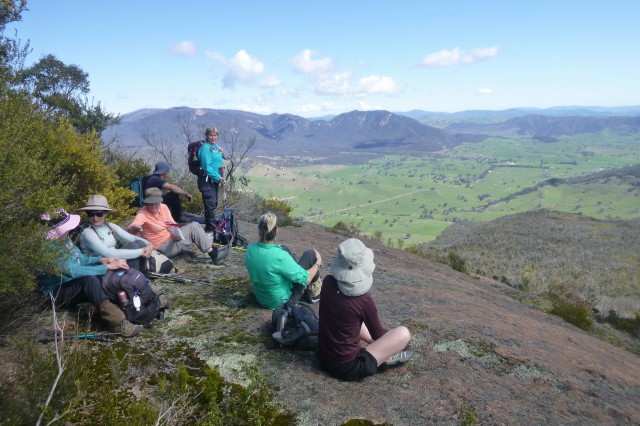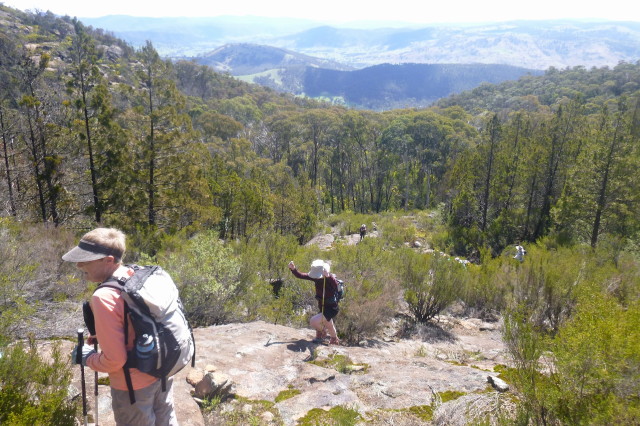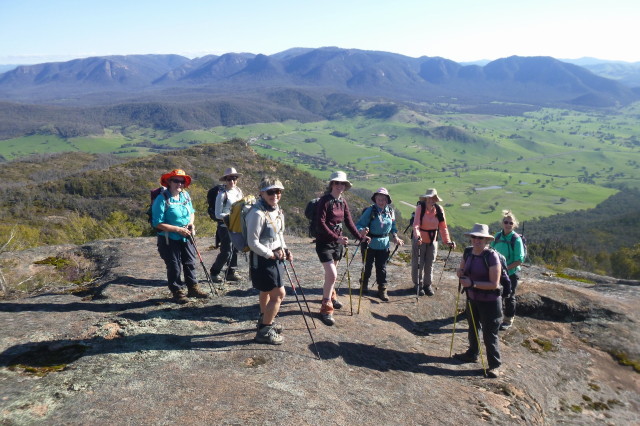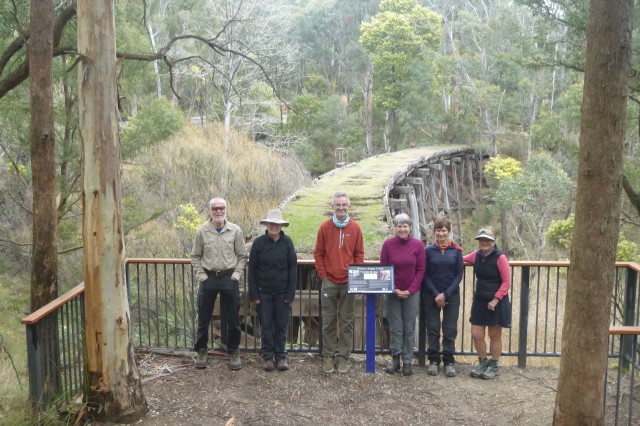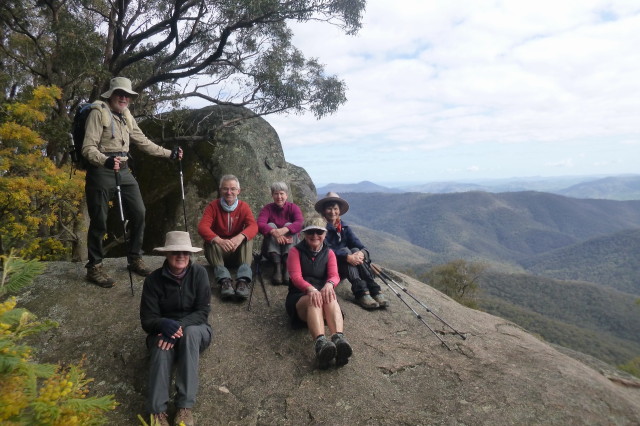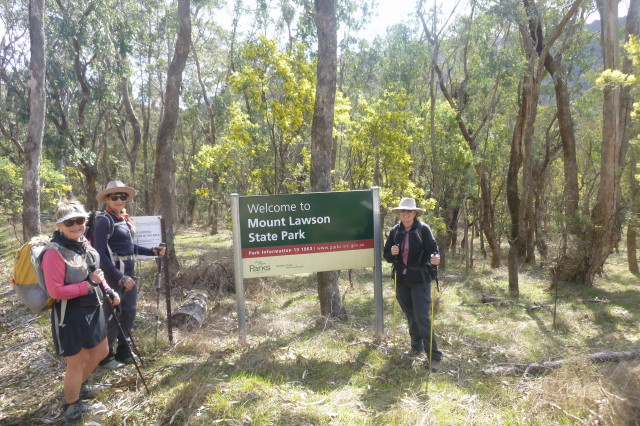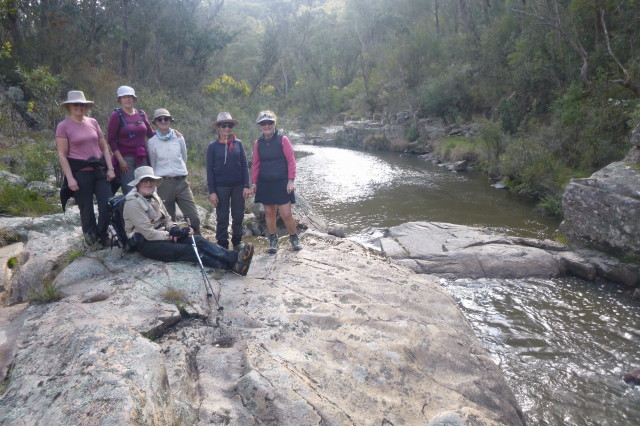On the weekend of Sept 6 – 8, 26 walkers descended upon ‘Clack Clack’ Caravan Park near Corryong, for walks within the area of Burrowa Pine Mountain National Park. The park is 18,400 hectares in size, features more than 200 native plants, and is reputedly one and a half times the size of Uluru.
The group met Friday evening 8pm in the camp kitchen for a briefing for Saturday’s walks. Several tracks were since closed within the park, from when Jeanette and I reconnoitered walks here in early April. Back then one track was closed, and now seven were off the agenda. During the briefing, my mispronunciation of some local towns, an amusement to some, and a cause of concern to others, were quickly corrected by Cecily.
Since then, this has given me the idea to pitch to television producers a new Australian show called, ‘Pronounce these Australian Towns and Places’. Shaun Micallef would be a perfect host, and it could fill that important 8.30pm Wednesday evening timeslot on ABC television. I can imagine the rights being sold worldwide, and would look forward to the Welsh version where vowels are almost non-existent.
Pine Mountain was the selected trail for all walkers on Saturday. Overnight showers had created a bright and fresh sunny day for hiking. We assembled at 7.45am, and were on the road via Corryong, Towong and Walwa. We reached the starting point about an hour later and after a group photo we began walking at 9.30am.
The short walkers would hike to Rocky Knob and then return, making a two-kilometre walk. Despite being very short, we had decided that the views over the park were essential for all to experience. This walk begins on an almost manicured track, with wattle blossoms in abundance and climbs about 50m. Rocky Knob is a picturesque spot, and was chosen for morning tea.
The medium and hard walkers continued towards another rocky outcrop which is about three kilometres from the start. This is a difficult climb to this point, and the total elevation gain of 300m was enough for some walkers to decide to wait by the track. One short rock section necessitated poles being put away, as hands and knees were needed for the scramble. I can attest to the degree of difficulty as I ended up with one scraped knee, and a small hole in my trousers. For those who ventured to this 900m elevation peak, the views were impressive. Wedge Tail eagles were observed in the sky. No doubt waiting to pick off lonely and isolated walkers along the track.
The group at this point divided into three. Medium walkers stayed to enjoy the view a little longer before returning. The longer walking group divided into two groups, and set off at their respective paces.
From here much of the hike is over large flat rock areas. Occasional orange markers and cairns assisted with navigation. Covered with moss and lichen in places made their traversing perilous at times. The tried and proven method of sliding on one’s backside proved popular, as did just slip and slide a little, while hoping for the best. After this rocky section a denser foliage path was encountered. The walking was easier as the track levelled out significantly.
The final climb towards Pine Mountain was again over large flat rock areas in an open area. A suitable space was chosen for lunch. Jeanette then led most of our group towards the top of the ridge.
Eden played her part by adding to a cairn, another carefully placed rock. They didn’t venture to the end unlike the first group, instead taking in the immediate views of the Murray, and valley views towards New South Wales.
Satisfied with our personal achievements, it was now a matter of retracing our steps back to the start. On our way, we encountered one young couple hiking towards the top with full packs, intent on camping overnight on the summit. Ah, to be young, energetic and foolhardy again.
Difficult uphill sections now became wonky knee testing downhill paths. Sandi Lee used a technique I have never encountered before. She would walk into small trees to slow her pace down. It proved effective, but I can’t vouch for the number of bruises she may have attained along the way. I can guarantee that no trees were harmed in her undertaking this walk. Finally, back at the lone remaining car at 5pm, the 10.5km hike was completed in 7.5 hours by the last group. A most rewarding, but challenging day hike.
Numerous additional activities were undertaken by walkers, once they had completed their Pine Mountain adventure. Helen and her group had the following experience.
[Our activities on Saturday afternoon included a coffee stop in Walwa with a very enthusiastic, pleasant young lady running the cafe/general store/ tourist information providing one of the best iced chocolates I have had anywhere!
The sculpture trail along River Road had us learning more about the local area and animals, as well as enjoying the sculptures of a lizard, Murray Cod and Bogong Moth. The Murray Cod is found high above the Murray River itself in Tintaldra where we learned much about the First World War Avenue of Honour, originally established by children from the Primary School. Information boards gave us an insight into the perceived importance of honouring the local men and women who served their country both far away, and at home, in times of war.
Viewing points along the sculpture trail provided names for the distant peaks of the Snowy Mountains which had some snow cover still visible, despite the below average snowfall and warming weather. Of special interest was the information about Grevillea Jephcottii – the green grevillea which I had seen just beginning to flower in Pine Mountain NP. These are unique to the area, and further investigation revealed that they were first discovered by local lad, 14 year old Sydney Jephcott, in 1878.
As we approached Corryong, I was thrilled to spot a eucalyptus camaldulensis (red gum) growing by the road which had been manipulated maybe 200 years ago by the indigenous population. Closer inspection revealed that at least two branches had been encouraged to grow into other branches to form non natural continuous shapes (“circles”), about three metres above ground level. Rather amazing.
The museum is clearly a much loved and well presented local institution. The stand out exhibition in the main building (there are 10 smaller buildings which we did not attempt to see in the time available!) was the hand knitted map of Australia, completed in six weeks by local Jim Simpson, after being taken prisoner when shot down over Germany on his first mission of the Second World War in 1940. His own hand knitted woollen jumper, quickly unravelled and wound into balls soon after arrival in camp, to prevent the Germans acquiring the garment and sending it to the Russian front, provided the starting point for the map which he began later in the war.
Jim used the skills his mother had taught him, to help his fellow prisoners learn how to knit socks to keep them warm! And to honour his mother, and all mothers of servicemen, he was inspired to use some of the many balls of wool the prisoners acquired, to knit the rug which measures approximately 2 metres by 2.1 metres. Complete with state boundaries, coats of arms and representations of mountains it is surprisingly accurate and skillfully knitted. Recognised as a symbol of the resilience of Australian soldiers it is an inspiration and well worth visiting the museum to see. Helen Twitt]
[Rod elected to take a more leisurely stroll as part of his Saturday morning, rather than walk Pine Mountain.
Birdwatchers walk differently. I walked to Corryong on the track, listening for bird calls, stopping to look for the caller; every dam, creek or wetland was scoured for birds. So we move slowly, marking our progress not so much in distance as in the number of birds. Overhead we watch for movements, flocks, eagles on thermals, where birds are flying to.
On this bird walk I noted 51 different species. Many of these were at the Corryong Poo Farm. Nutrient rich water attracts hundreds of them. Grebes, 5 different species of ducks, swans, cormorants, stilts, welcome swallows, mudlarks and a kestrel sitting on tree. I spent an hour here constantly watching.
Birdwatchers look for seasonal changes. I saw a small clutch of tree martins, obviously part of a migration. Rufous Whistlers were everywhere as they arrived in the district. On the flat area I watched Flame Robins ready for their altitudinal migration to the summer food and breeding in the high country.
Overall, I walked about seven kilometres for the day. But slowly, absorbing the bird world, listening all the time, being absorbed in a different way to many walkers and the unique pleasures that they find in the bush. All part of the enjoyment of the outdoors. Rod Davis]
Dinner was held Saturday evening at the Cudgewa Hotel. Following the meals descriptions for Sunday walks were provided. These were to be in Shelley, Koetong and Mount Lawson State Park. For most people this allowed walks to be completed on their way home. It was proposed to the group that we meet at 9am in the morning rather than the original planned time of 7.45am. A more resounding yes has never in the history of mankind been received.
[Adrian shares the adventures of his walking group on Sunday.
Thirteen walkers participated in the easier walks on Sunday. Participants converged on the Mountain Creek Nature Trail at Shelley in the morning, a two kilometre walk through largely dense forest. Helen scooped up the only leaflet (later returned) from the information box, a brochure covering the highlights at 20 information spots along the way, read to participants at each stop. One walker asked if there was to be a test at the end! Highlights included the bubbling Mountain Creek itself, and the powder magazine once used to store explosives used for creating forest tracks required by pine plantation workers decades ago.
The afternoon walk was somewhat of a contrast. Our aim was to walk seven kilometres from a point along the Shelley rail trail towards the huge trestle bridge beyond the former Koetong railway station. We were delighted to come across several trestle bridges in this rugged country. Tall timber, and another gushing mountain stream, added to this delightful walk. Lunch was held overlooking one of the rare farms. A curious horse, enviously gazing across the fence at the contents of our lunchboxes, was rewarded with surplus lettuce and apples.
Those of us who didn’t trip on the sticks and debris along this rail trail, or fall down a wombat hole, enjoyed the hike along this engineering feat, once the highest railway in Victoria. Adrian Twitt]
Finally, the medium walkers chose several walks to create a day of hiking. Beginning with a visit to the Koetong Trestle bridge, it was then followed by a drive to the Conic Rocks. The short 750m walk to these large boulders gave great views to the east, and northeast, of the park and beyond. Sandie observed a small cluster of orchids upon our return. Morning tea was taken at the picnic table before departing for the next location.
A short car shuffle was required for the next hike involving The Spa and Grandmother’s Track. After a little panic regarding some momentarily misplaced car keys, the group was ready to begin. I must admit that the Grandmother’s Track is well… nothing to write home to your granny about. Simply a four-wheel drive road that undulates a little before meeting up with Mount Lawson Road. Fallen trees along the side of the road, did make for a suitable lunch spot.
The Koetong Creek River track leads to what is known as The Spa. Two campsites along the way looked idyllic near the river, however we were walking some distance from the water. Just as we reached The Spa junction, Murray had stopped ahead of us. Two wombats, possibly a mother and her young, were quietly feeding on grass adjacent to the road. We were able to observe them for a couple of minutes before they hurriedly retreated into the bush.
The Spa Track descends to the river. It was a beautiful spot with a cascading waterfall, and some suitable water holes which would make refreshing places to take a dip on a hot day. We enjoyed the surroundings for a time, taking the obligatory photos before returning the way we had come. Murray, who is obviously training for the 2028 Olympics, strode ahead to bring his car closer for the rest of us. Despite his herculean effort, time was beginning to get away from us. The drive to Mount Lawson summit was abandoned from our program, and we returned to the Trestle Bridge to end our day. Our Spa Track walk, incorporating Grandmother’s Track, was a hike of almost 10km completed in three hours.
Many thanks to the extra contributors, Rod Davis, Adrian and Helen Twitt for their descriptions of their day’s activities. Thanks to Kelton Goyne from Parks Victoria, and Jeanette who assisted in ideas for alternative walks. It would be great to complete a version 2.0 weekend in this region when all tracks are open again to bushwalkers. Finally, the walkers who have completed their test questions on the Mountain Creek Nature Trail, can simply email their answers to Adrian and Helen. First prize is an evening dinner for two at the Cudgewa Hotel. Second prize is an evening dinner for 25 at the Cudgewa Hotel.
Michael Braendler

